height PONTIAC TORRENT 2007 Owners Manual
[x] Cancel search | Manufacturer: PONTIAC, Model Year: 2007, Model line: TORRENT, Model: PONTIAC TORRENT 2007Pages: 490, PDF Size: 2.71 MB
Page 7 of 490
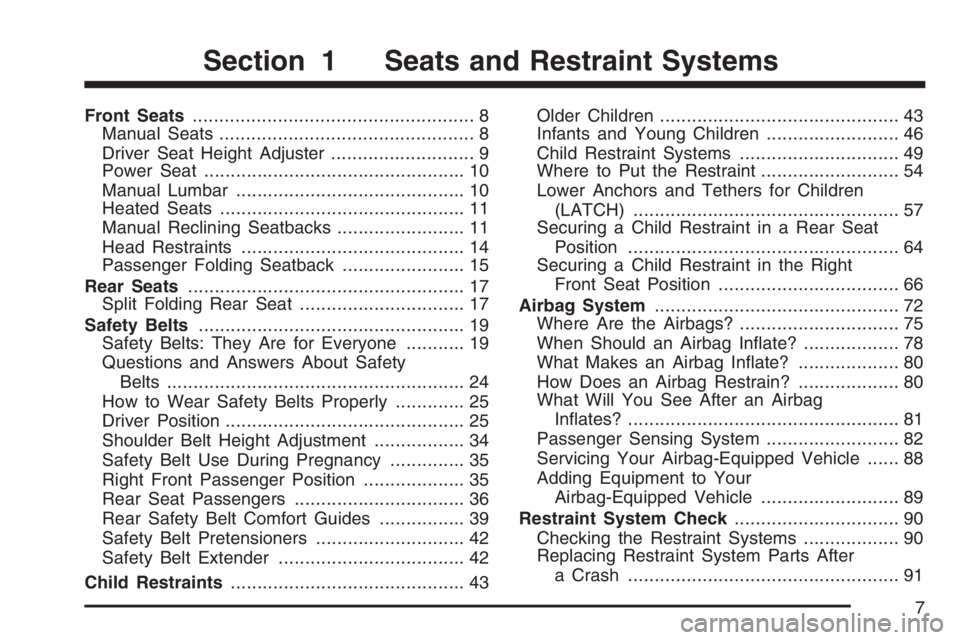
Front Seats..................................................... 8
Manual Seats................................................ 8
Driver Seat Height Adjuster........................... 9
Power Seat................................................. 10
Manual Lumbar........................................... 10
Heated Seats.............................................. 11
Manual Reclining Seatbacks........................ 11
Head Restraints.......................................... 14
Passenger Folding Seatback....................... 15
Rear Seats.................................................... 17
Split Folding Rear Seat............................... 17
Safety Belts.................................................. 19
Safety Belts: They Are for Everyone........... 19
Questions and Answers About Safety
Belts........................................................ 24
How to Wear Safety Belts Properly............. 25
Driver Position............................................. 25
Shoulder Belt Height Adjustment................. 34
Safety Belt Use During Pregnancy.............. 35
Right Front Passenger Position................... 35
Rear Seat Passengers................................ 36
Rear Safety Belt Comfort Guides................ 39
Safety Belt Pretensioners............................ 42
Safety Belt Extender................................... 42
Child Restraints............................................ 43Older Children............................................. 43
Infants and Young Children......................... 46
Child Restraint Systems.............................. 49
Where to Put the Restraint.......................... 54
Lower Anchors and Tethers for Children
(LATCH).................................................. 57
Securing a Child Restraint in a Rear Seat
Position................................................... 64
Securing a Child Restraint in the Right
Front Seat Position.................................. 66
Airbag System.............................................. 72
Where Are the Airbags?.............................. 75
When Should an Airbag In�ate?.................. 78
What Makes an Airbag In�ate?................... 80
How Does an Airbag Restrain?................... 80
What Will You See After an Airbag
In�ates?................................................... 81
Passenger Sensing System......................... 82
Servicing Your Airbag-Equipped Vehicle...... 88
Adding Equipment to Your
Airbag-Equipped Vehicle.......................... 89
Restraint System Check............................... 90
Checking the Restraint Systems.................. 90
Replacing Restraint System Parts After
a Crash................................................... 91
Section 1 Seats and Restraint Systems
7
Page 9 of 490
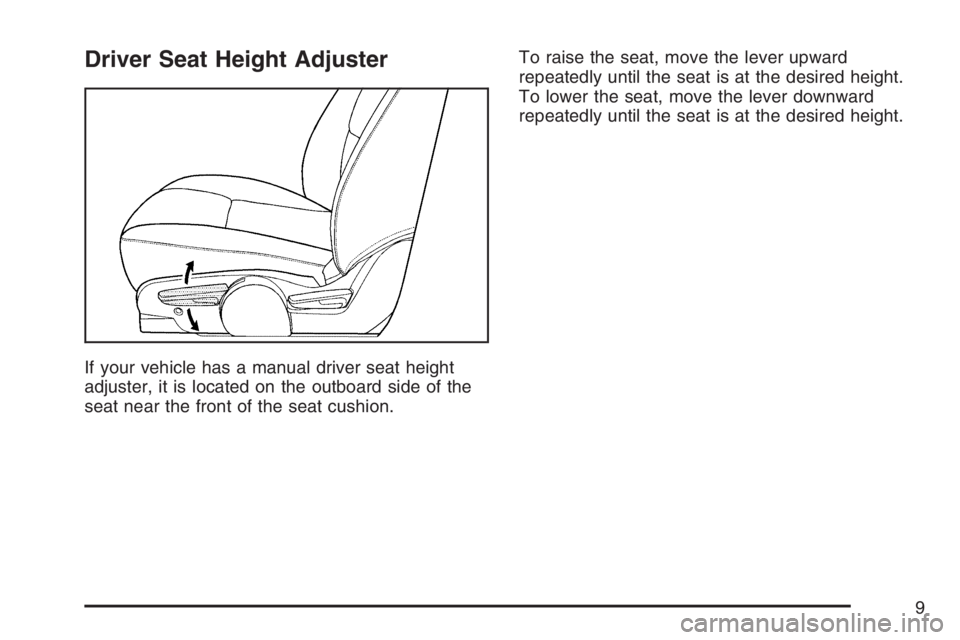
Driver Seat Height Adjuster
If your vehicle has a manual driver seat height
adjuster, it is located on the outboard side of the
seat near the front of the seat cushion.To raise the seat, move the lever upward
repeatedly until the seat is at the desired height.
To lower the seat, move the lever downward
repeatedly until the seat is at the desired height.
9
Page 12 of 490
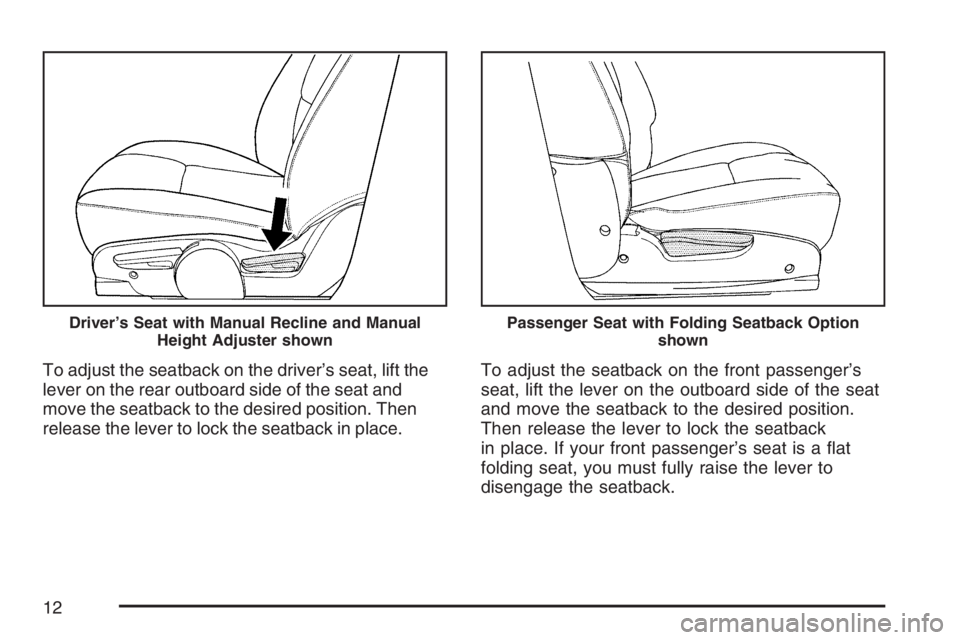
To adjust the seatback on the driver’s seat, lift the
lever on the rear outboard side of the seat and
move the seatback to the desired position. Then
release the lever to lock the seatback in place.To adjust the seatback on the front passenger’s
seat, lift the lever on the outboard side of the seat
and move the seatback to the desired position.
Then release the lever to lock the seatback
in place. If your front passenger’s seat is a �at
folding seat, you must fully raise the lever to
disengage the seatback.
Driver’s Seat with Manual Recline and Manual
Height Adjuster shownPassenger Seat with Folding Seatback Option
shown
12
Page 14 of 490
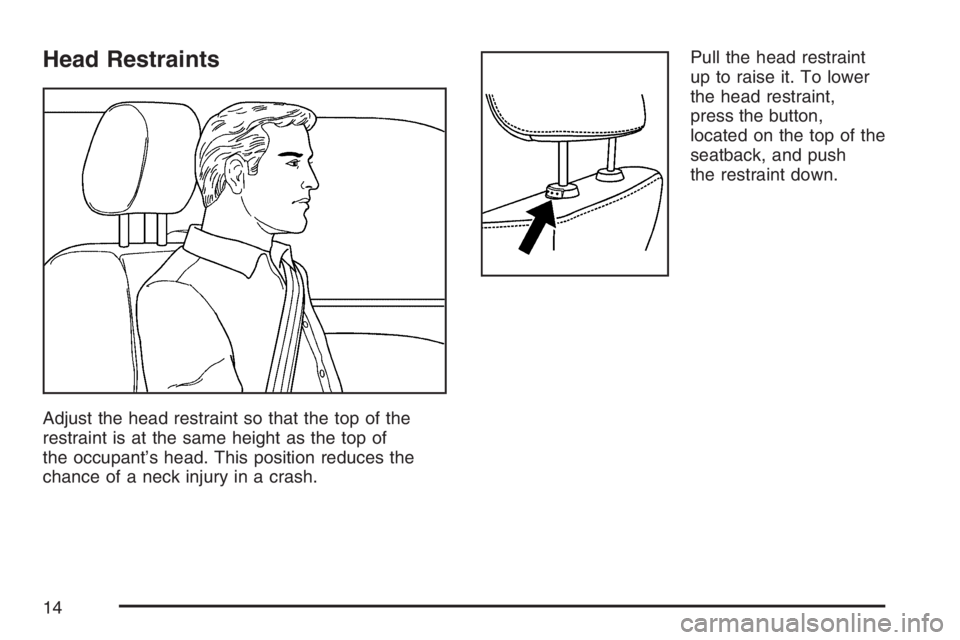
Head Restraints
Adjust the head restraint so that the top of the
restraint is at the same height as the top of
the occupant’s head. This position reduces the
chance of a neck injury in a crash.Pull the head restraint
up to raise it. To lower
the head restraint,
press the button,
located on the top of the
seatback, and push
the restraint down.
14
Page 26 of 490
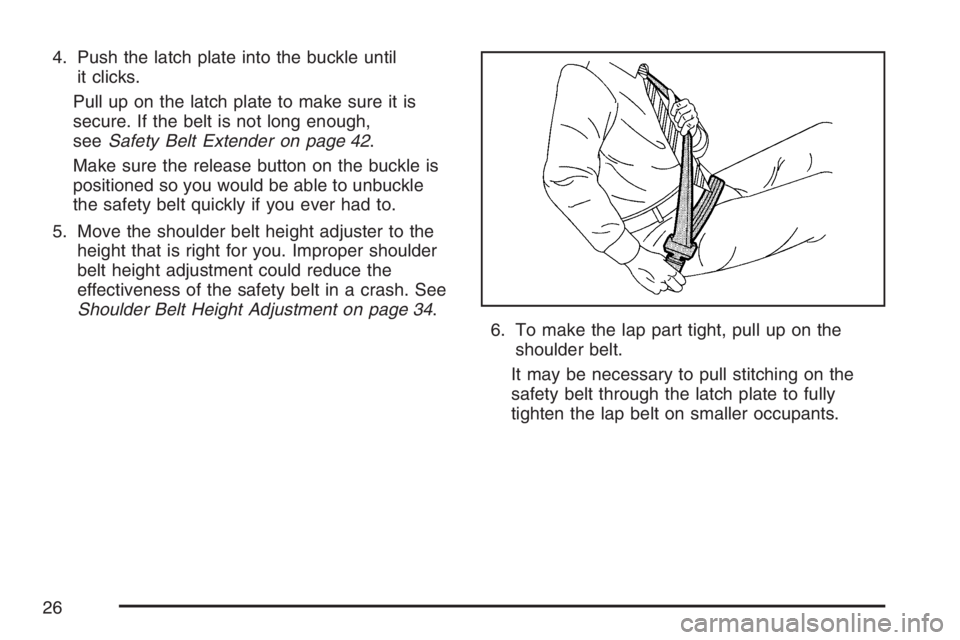
4. Push the latch plate into the buckle until
it clicks.
Pull up on the latch plate to make sure it is
secure. If the belt is not long enough,
seeSafety Belt Extender on page 42.
Make sure the release button on the buckle is
positioned so you would be able to unbuckle
the safety belt quickly if you ever had to.
5. Move the shoulder belt height adjuster to the
height that is right for you. Improper shoulder
belt height adjustment could reduce the
effectiveness of the safety belt in a crash. See
Shoulder Belt Height Adjustment on page 34.
6. To make the lap part tight, pull up on the
shoulder belt.
It may be necessary to pull stitching on the
safety belt through the latch plate to fully
tighten the lap belt on smaller occupants.
26
Page 34 of 490
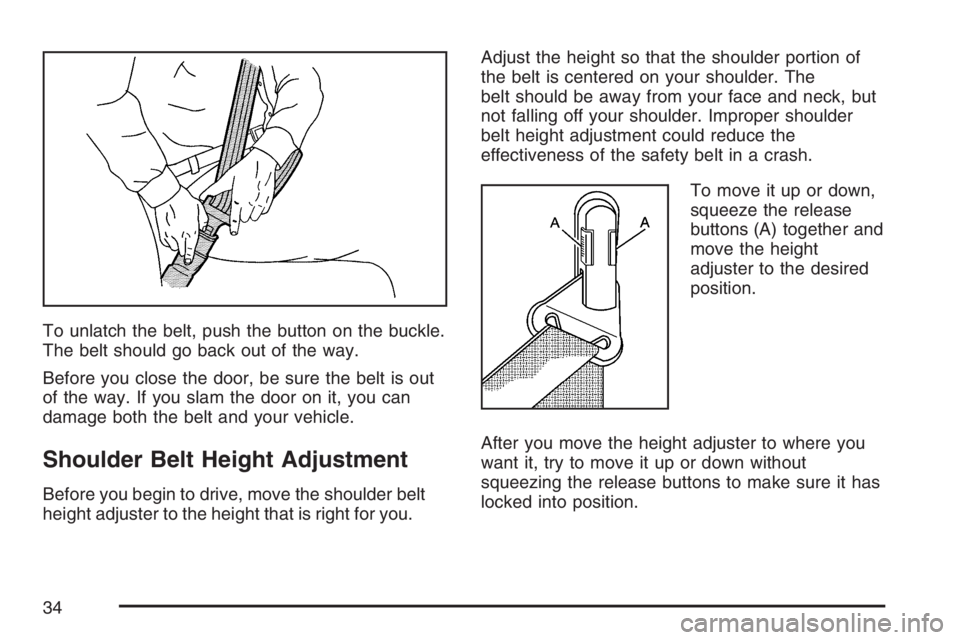
To unlatch the belt, push the button on the buckle.
The belt should go back out of the way.
Before you close the door, be sure the belt is out
of the way. If you slam the door on it, you can
damage both the belt and your vehicle.
Shoulder Belt Height Adjustment
Before you begin to drive, move the shoulder belt
height adjuster to the height that is right for you.Adjust the height so that the shoulder portion of
the belt is centered on your shoulder. The
belt should be away from your face and neck, but
not falling off your shoulder. Improper shoulder
belt height adjustment could reduce the
effectiveness of the safety belt in a crash.
To move it up or down,
squeeze the release
buttons (A) together and
move the height
adjuster to the desired
position.
After you move the height adjuster to where you
want it, try to move it up or down without
squeezing the release buttons to make sure it has
locked into position.
34
Page 48 of 490
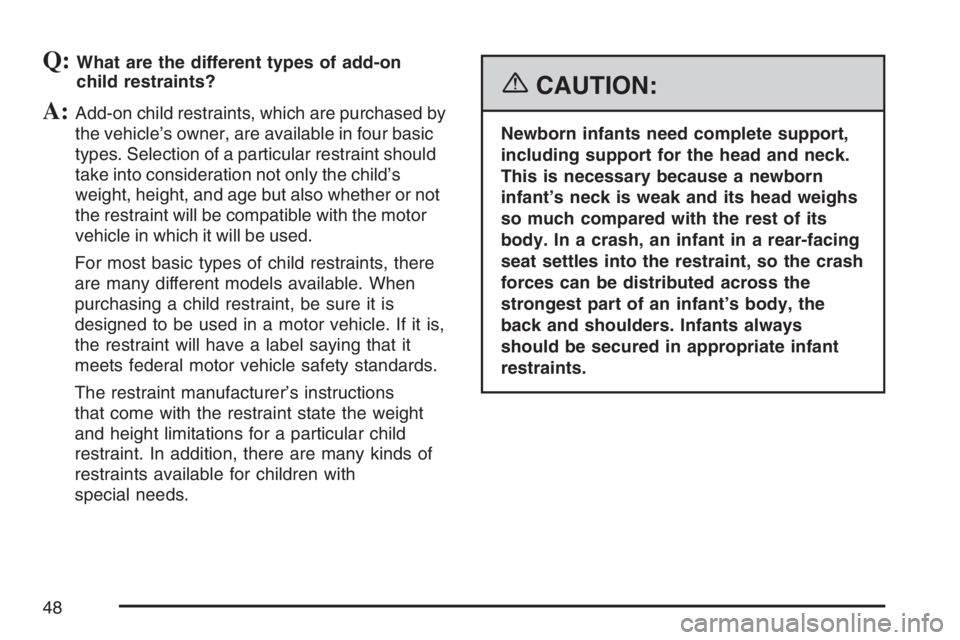
Q:What are the different types of add-on
child restraints?
A:Add-on child restraints, which are purchased by
the vehicle’s owner, are available in four basic
types. Selection of a particular restraint should
take into consideration not only the child’s
weight, height, and age but also whether or not
the restraint will be compatible with the motor
vehicle in which it will be used.
For most basic types of child restraints, there
are many different models available. When
purchasing a child restraint, be sure it is
designed to be used in a motor vehicle. If it is,
the restraint will have a label saying that it
meets federal motor vehicle safety standards.
The restraint manufacturer’s instructions
that come with the restraint state the weight
and height limitations for a particular child
restraint. In addition, there are many kinds of
restraints available for children with
special needs.
{CAUTION:
Newborn infants need complete support,
including support for the head and neck.
This is necessary because a newborn
infant’s neck is weak and its head weighs
so much compared with the rest of its
body. In a crash, an infant in a rear-facing
seat settles into the restraint, so the crash
forces can be distributed across the
strongest part of an infant’s body, the
back and shoulders. Infants always
should be secured in appropriate infant
restraints.
48
Page 89 of 490
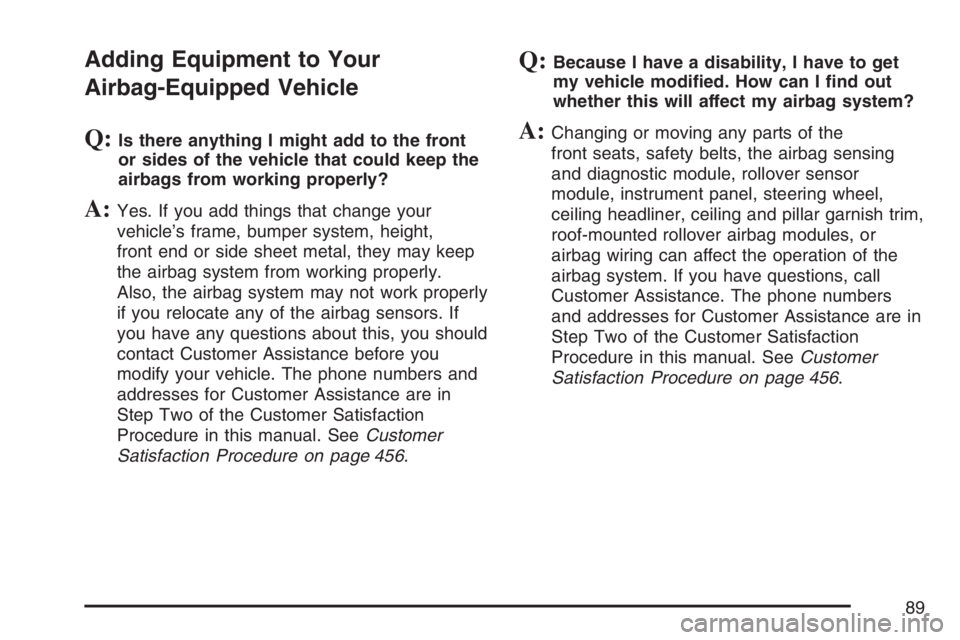
Adding Equipment to Your
Airbag-Equipped Vehicle
Q:Is there anything I might add to the front
or sides of the vehicle that could keep the
airbags from working properly?
A:Yes. If you add things that change your
vehicle’s frame, bumper system, height,
front end or side sheet metal, they may keep
the airbag system from working properly.
Also, the airbag system may not work properly
if you relocate any of the airbag sensors. If
you have any questions about this, you should
contact Customer Assistance before you
modify your vehicle. The phone numbers and
addresses for Customer Assistance are in
Step Two of the Customer Satisfaction
Procedure in this manual. SeeCustomer
Satisfaction Procedure on page 456.
Q:Because I have a disability, I have to get
my vehicle modi�ed. How can I �nd out
whether this will affect my airbag system?
A:Changing or moving any parts of the
front seats, safety belts, the airbag sensing
and diagnostic module, rollover sensor
module, instrument panel, steering wheel,
ceiling headliner, ceiling and pillar garnish trim,
roof-mounted rollover airbag modules, or
airbag wiring can affect the operation of the
airbag system. If you have questions, call
Customer Assistance. The phone numbers
and addresses for Customer Assistance are in
Step Two of the Customer Satisfaction
Procedure in this manual. SeeCustomer
Satisfaction Procedure on page 456.
89
Page 129 of 490
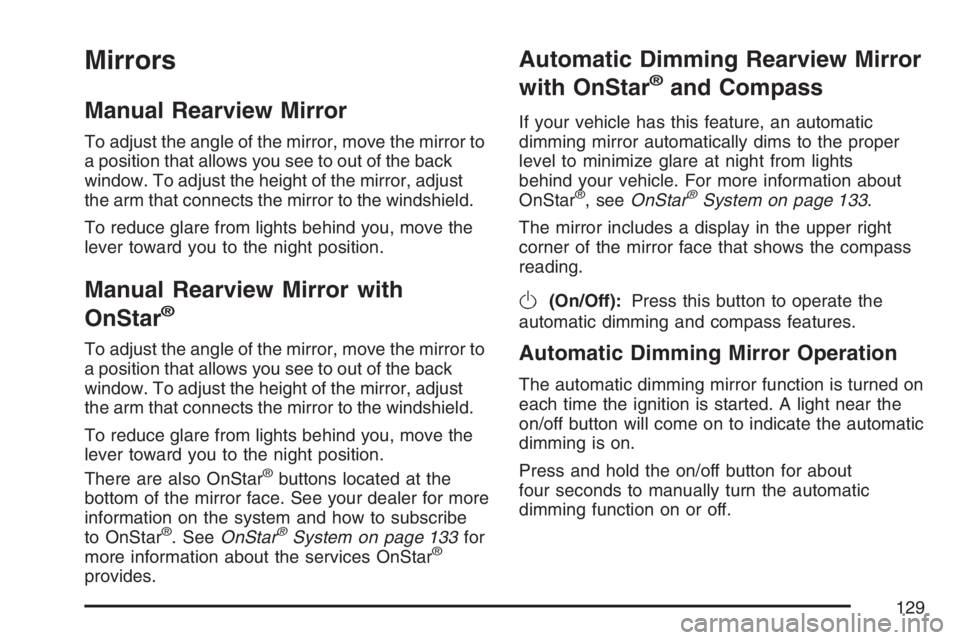
Mirrors
Manual Rearview Mirror
To adjust the angle of the mirror, move the mirror to
a position that allows you see to out of the back
window. To adjust the height of the mirror, adjust
the arm that connects the mirror to the windshield.
To reduce glare from lights behind you, move the
lever toward you to the night position.
Manual Rearview Mirror with
OnStar
®
To adjust the angle of the mirror, move the mirror to
a position that allows you see to out of the back
window. To adjust the height of the mirror, adjust
the arm that connects the mirror to the windshield.
To reduce glare from lights behind you, move the
lever toward you to the night position.
There are also OnStar
®buttons located at the
bottom of the mirror face. See your dealer for more
information on the system and how to subscribe
to OnStar
®. SeeOnStar®System on page 133for
more information about the services OnStar®
provides.
Automatic Dimming Rearview Mirror
with OnStar
®and Compass
If your vehicle has this feature, an automatic
dimming mirror automatically dims to the proper
level to minimize glare at night from lights
behind your vehicle. For more information about
OnStar
®, seeOnStar®System on page 133.
The mirror includes a display in the upper right
corner of the mirror face that shows the compass
reading.
O(On/Off):Press this button to operate the
automatic dimming and compass features.
Automatic Dimming Mirror Operation
The automatic dimming mirror function is turned on
each time the ignition is started. A light near the
on/off button will come on to indicate the automatic
dimming is on.
Press and hold the on/off button for about
four seconds to manually turn the automatic
dimming function on or off.
129
Page 371 of 490
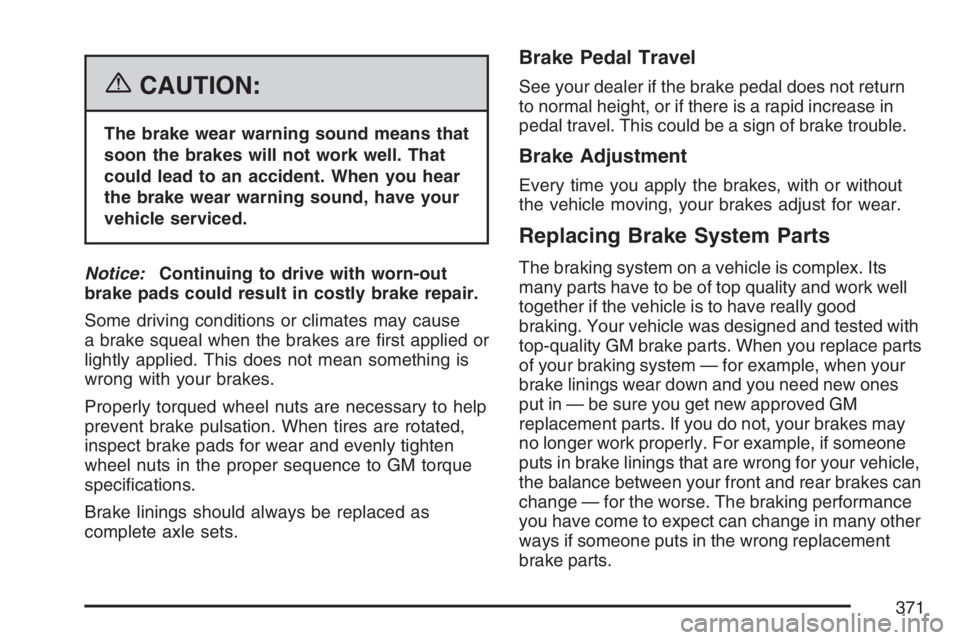
{CAUTION:
The brake wear warning sound means that
soon the brakes will not work well. That
could lead to an accident. When you hear
the brake wear warning sound, have your
vehicle serviced.
Notice:Continuing to drive with worn-out
brake pads could result in costly brake repair.
Some driving conditions or climates may cause
a brake squeal when the brakes are �rst applied or
lightly applied. This does not mean something is
wrong with your brakes.
Properly torqued wheel nuts are necessary to help
prevent brake pulsation. When tires are rotated,
inspect brake pads for wear and evenly tighten
wheel nuts in the proper sequence to GM torque
speci�cations.
Brake linings should always be replaced as
complete axle sets.
Brake Pedal Travel
See your dealer if the brake pedal does not return
to normal height, or if there is a rapid increase in
pedal travel. This could be a sign of brake trouble.
Brake Adjustment
Every time you apply the brakes, with or without
the vehicle moving, your brakes adjust for wear.
Replacing Brake System Parts
The braking system on a vehicle is complex. Its
many parts have to be of top quality and work well
together if the vehicle is to have really good
braking. Your vehicle was designed and tested with
top-quality GM brake parts. When you replace parts
of your braking system — for example, when your
brake linings wear down and you need new ones
put in — be sure you get new approved GM
replacement parts. If you do not, your brakes may
no longer work properly. For example, if someone
puts in brake linings that are wrong for your vehicle,
the balance between your front and rear brakes can
change — for the worse. The braking performance
you have come to expect can change in many other
ways if someone puts in the wrong replacement
brake parts.
371